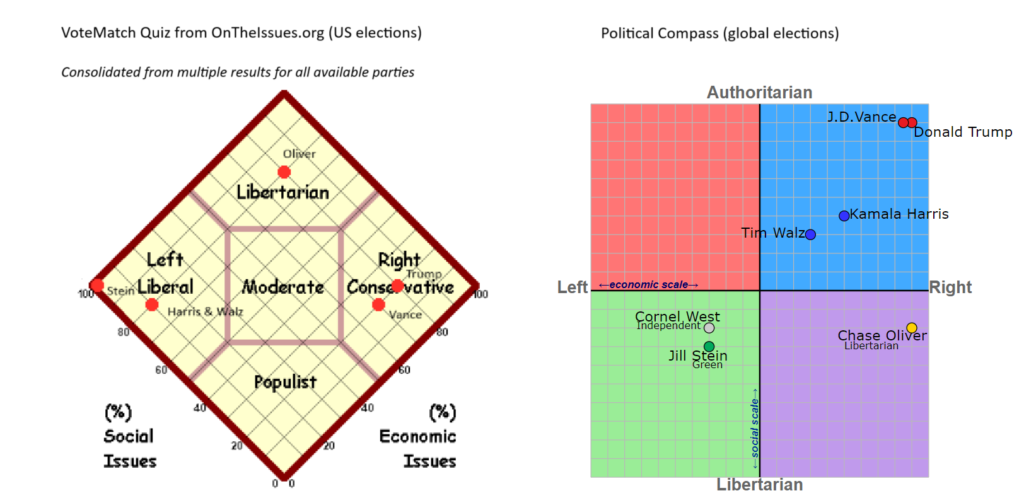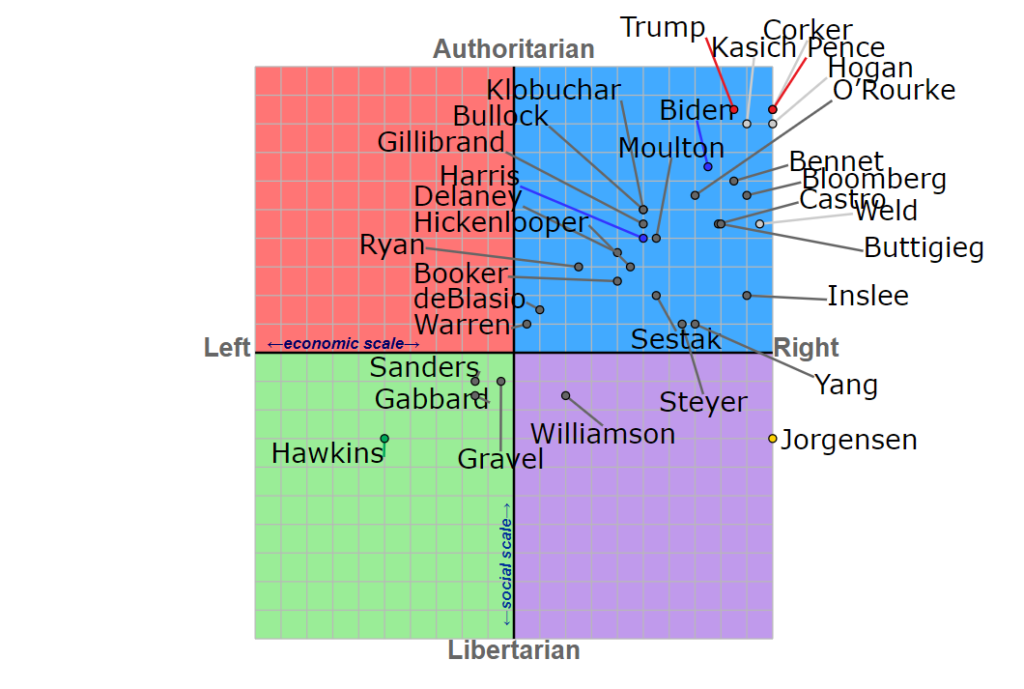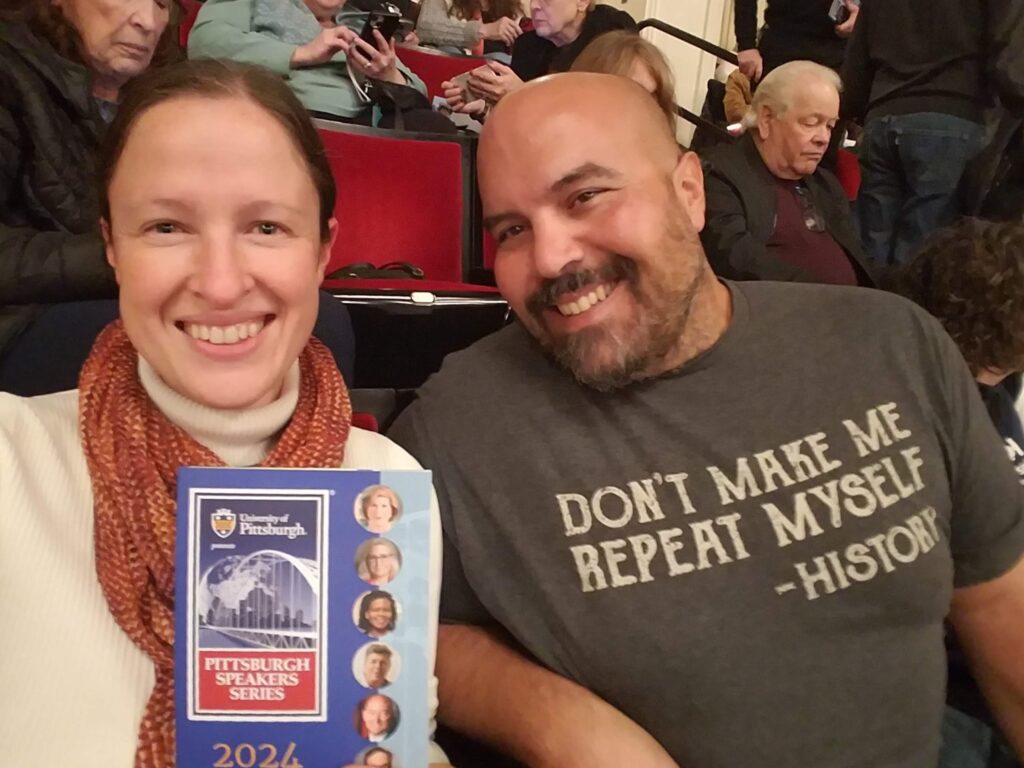Part 2
I’ve been enjoying a book I bought for my mom a few years ago, which I grabbed on a recent trip back east: Starry Messenger: Cosmic Perspectives on Civilization, by Neil deGrasse Tyson. [1] In this book, he describes the concept that once you gain a higher-level perspective (sometimes literally, in the case of astronauts), our divisions – including ones that absolutely define us in our daily lives – start to look pretty insignificant, and that we really do have more uniting us than we have dividing us. [2] It’s akin to the concept I described in last week’s post about how we apply labels to ourselves and others, resulting in the inclusion of those with the same labels and exclusion of those with different labels. [3]

Image credits: On The Issues [4] and Political Compass [5]
Every four years in the United States, some of the most polarizing labels we see in play are “Democrat” and “Republican.” I, like many others in this country, grew up in a house where one of those labels was a bad word, leading me to infer, as a child, that those with that label were bad people. Of course, I have learned over the years that that isn’t the case as I get to know and respect people with a range of life experiences and perspectives – and as I learn more about different social and economic theories, myself. Such a broadening of perspective can serve to shift our mindsets toward more inclusive labels (“Democrat/Republican” → “American”), but it typically takes a lot of intentional effort or some kind of life-changing event to get us there.
Cosmic Perspective
A great way to understand how limited our perspective is in the United States is by comparing how we view ourselves versus how we are viewed abroad. Some of the sources I have relied upon most frequently when doing my semi-annual research on election candidates include On The Issues, a US-based, non-partisan organization that consolidates information about candidates in US elections [6] and The Political Compass, a UK-based effort that does the same thing for elections around the world. [7] Logic might tell you that an American-run analysis that only has American politicians for comparison is going to look decidedly different than one examining American politicians within the broader context of a global set of politicians who have much more varied political stances, but it still surprises most people I know when they see it for the first time.
On The Issues puts Harris and Trump on opposing ends of their map, labeling them “hard-core liberal” and “hard-core conservative,” respectively. (I have to say I find that label odd for Harris, since I recall her being fairly middle-of-the-pack in the 2020 democratic primary; certainly not a “hard-core liberal” compared to some of the other candidates in that group. But I digress…) The Political Compass, on the other hand, generally shows a lot less daylight between the two major parties in the US, regularly placing them both in the same quadrant: high government control and conservative economics. Of course there are variations within categories, but friends of mine generally express a bit of shock or disbelief when they see democrats and republicans sitting near each other in the “authoritarian right.”

Image credit: [8]
So much of that shock comes from the fact that many of our news outlets focus on division to start with, while social media engagement thrives on turmoil and conflict. Our divisions have grown in recent years, a trend noted by the Pew Research Center even before the 2016 election, [9] but it feels like things have continued to worsen since then. Case in point: when I made an appeal on Facebook last week to reverse the growing divide we’re seeing, one friend asked if we really needed to, and another seemed to imply that it can’t be done. Certainly, there are many who hold similar opinions, especially in election years when many members of either major political party view the “other side” as the enemy. Vitriol, emotions, and misinformation were so high in the last election cycle that we witnessed a unique and violent attack on something we’ve come to take for granted in our democracy: the peaceful transfer of power.
Common Ground
In the hours after the Capitol riot, Christian and I watched the news in abject horror, holding our breath as events unfolded; I tried patiently explaining to a family member who had watched different news coverage that, no, it was not a peaceful protest, and, yes, it had been extremely violent. In the weeks and months to come, some (not all, but some) in Washington seemed to shift away from their partisan labels and toward a more-inclusive, higher-level one: patriots defending our democracy. And that label has held for many of them as they’ve invited people of all parties (or no parties) to join them so we can move forward together from one of the darkest days in American history. Just this last week, Christian and I were fortunate to hear from one such patriot when she came to speak in Pittsburgh as part of a lecture series. [10]
Liz Cheney’s remarks about her time serving on the House Select Committee on the January 6 Attack [11] were impressive, but just as impressive to me was the very obvious mix of political parties represented in the audience (which I inferred based on who around us laughed, clapped, or remained silent after certain anecdotes spanning her time in politics). There is no doubt she still holds to her Republican values, and she made no secret of the criticism she has directed across the aisle over the years. But it was heartening to hear her experience of gaining respect for prominent Democrats, such as Nancy Pelosi for her commitment to support colleagues on the Select Committee regardless of party and Kamala Harris for her demonstrated ability to serve the country as a “responsible, stable adult” who believes in the rule of law.

It felt almost like a State of the Union address, with frequent eruptions of applause – except, unlike a State of the Union address, that applause mostly came from the entire audience, not just members of the speaker’s party. What could unite a mixed political crowd in such fervor during an election year, you may ask? Calls for integrity from our government and the people who serve in it; for recognition of our obligation as human beings to stand up for what’s right; for responsible consumption of media and accountability for members of the press; for putting patriotism above party, as Al Gore called us to do in his December 13, 2000 concession speech (which I would strongly suggest watching if you want to see how it should be done). [12]
Once again, I will say that I know finding common ground is easier said than done, especially in the run-up to an election. It is made more difficult with the knowledge that Election Day does not represent the end of this work but instead the beginning of a healing process, one that needs to happen regardless of the outcome of the election. And we’ll continue next week with ways that healing process might take shape.
In the meantime, a more complete (but still not final) election spreadsheet is included here in case it’s helpful for anyone still doing research:
Please share your thoughts, questions, and ideas below – I would love to hear them.
Thanks for reading!
[1] https://www.goodreads.com/book/show/59808487-starry-messenger
[2] https://www.youtube.com/watch?v=hWZeJsYTEMU
[3] https://radicalmoderate.online/2024-general-election-part-1-pennsylvania-here-i-come/
[5] https://www.politicalcompass.org/uselection2024
[7] https://www.politicalcompass.org/
[8] https://www.politicalcompass.org/uselection2020
[9] https://www.pewresearch.org/politics/2014/06/12/political-polarization-in-the-american-public/
[10] https://www.pittsburghspeakers.org/speakers/
[11] https://en.wikipedia.org/wiki/United_States_House_Select_Committee_on_the_January_6_Attack
[12] https://www.youtube.com/watch?v=Xq5YdkYSyEE
0 Comments